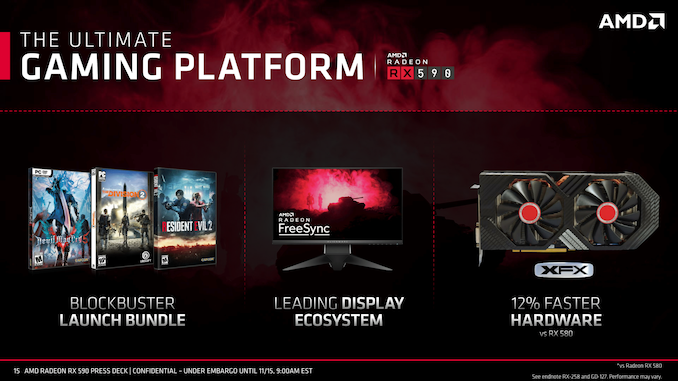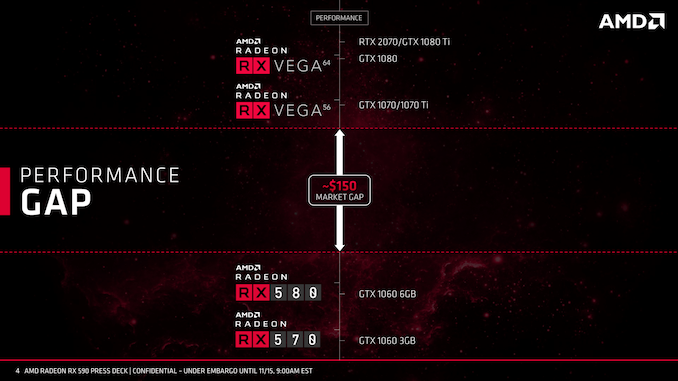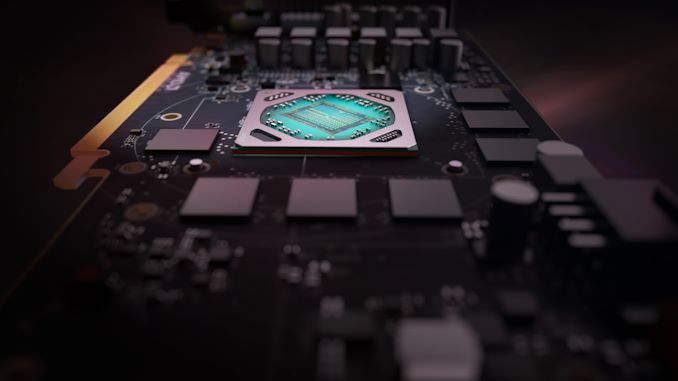The AMD Radeon RX 590 Review, feat. XFX & PowerColor: Polaris Returns (Again)
by Nate Oh on November 15, 2018 9:00 AM ESTClosing Thoughts
As we bring this to a close, the Radeon RX 590 features few, if any, surprises, indeed outperforming the RX 580 via higher clockspeeds but at the cost of additional power consumption. This is enabled by being fabbed on 12nm and being afforded higher TBPs, but in terms of overall effect, the port to 12nm is less of a die shrink and more of a new stepping; in terms of transistor count and die size Polaris 30 is identical to Polaris 10. Feature-wise, whereas the RX 500 series did introduce a new mid-power memory state, the RX 590 doesn't add anything.
Altogether, AMD is helping push the RX 590 along with a three-game launch bundle and emphasizing the value of FreeSync monitors. One might add that the RX 590 also makes the most out of the game bundle, which now presents itself as a direct value-add for the card. But the card by itself isn't providing more bang for your buck than with the RX 580.
By the numbers, then, where does the RX 590 land? Reference-to-reference, the RX 590 is about 12% faster than the RX 580 at 1080p/1440p, and 14-15% faster than the RX 480. Across the aisle, this turns out to be 9% faster than the reference GTX 1060 6GB, though the GeForce card still takes the lead in games like GTA V and Total War: Warhammer II. That matchup itself is more-or-less an indicator of how far Polaris has come - the RX 480 at launch was 11% behind the GTX 1060 6GB, and the RX 580 at launch was 7% behind. Improvements have come over the years with drivers and such, where the RX 480 and RX 580 are much closer, but the third time around, Polaris can finally claim the victory at launch.
That being said, the 9% margin is well within reach of factory-overclocked GTX 1060 6GB cards, especially with a 9Gbps option that the RX 590 doesn't have. Even with the XFX Radeon RX 590 Fatboy the delta only increases to about 11%. In other words, as custom factory-overclocked cards the RX 590 and GTX 1060 6GB are likely to trade blows. And heavily factory-overclocked RX 580s are in the similar situation.
But similar to the RX 580 and 570, the RX 590 achieves this at the cost of even more power consumption. In practical situations like in Battlefield 1, the RX 590 results in the system pulling around 110W more from the wall than with the GTX 1060 6GB. The RX 590 is not a power efficient card at the intended clocks and TBP, and so won't be suitable for SFF builds or reducing air conditioning usage.
Once again though, we've observed that VRAM is never enough. It was only a few years ago that 8GB of VRAM was considered excessive, only useful for 4K. But especially with the popularity of HD texture packs, even 6GB of framebuffer could prove limiting at 1080p with graphically demanding games. In that respect, the RX 590's 8GB keeps it covered but also brings additional horsepower over the 8GB R9 390. For memoryhogging games like Shadow of War, Wolfenstein II, or now Far Cry 5 (with HD textures), the 8GBs go a long way. Even at 1080p, GTX 980/970 performance in Wolfenstein II tanks because of the lack of framebuffer. For those looking to upgrade from 2GB or 4GB cards, both the RX 580 and RX 590 should be of interest.
So in terms of a performance gap, the custom RX 590s seem poised to fill in, though it might be in the range of 5 to 10% when comparing to existing heavily factory-overclocked RX 580s. That gap, of course, would likely have been filled by a 'Vega 11' product, which never came to fruition. Beyond a smaller discrete Vega GPU, 12nm Vega seems less likely given that 14nm+ Vega is no longer on the roadmap. And with 7nm Vega announced as Radeon Instinct MI60 and MI50 accelerators, there's no current indication of those GPUs coming into the consumer space. We also know very little about Navi other than being fabbed with TSMC on 7nm and due in 2019.
So of the possible cards in AMD’s deck, we are seeing a single 12nm Polaris SKU slotting in above the existing RX 580. If there are no further refreshes coming, then gamers will naturally ask when Polaris will be replaced as AMD's mainstream offering, as otherwise the RX 500 series will be holding the fort until then. If this is a prelude to further refreshes, then it becomes a question of how much more performance can be squeezed from Polaris.
The bigger picture is that from the consumer point-of-view, RX Vega in August 2017 was the most recent video card launch before today. There are more pressing concerns in the present: NVIDIA's recently-launched Turing-based GeForce RTX 20 series, as well as Intel's renewed ambition for discrete graphics and subsequent graphics talent leaving AMD for Intel. While the RX 590 avoids the optics of having no hardware response whatsoever in the wake of the RTX 20 cards, it is still a critical juncture with respect to DirextX Raytracing (DXR) development. And regardless, Intel has announced 2020 as the date for their modern discrete GPUs.
So as we head into 2019, it will be a crucial year for AMD and RTG. But returning to the Radeon RX 590, it applies pressure to the GTX 1060 6GB and older GTX 900 series cards, while avoiding direct pressure on existing RX 580 inventory by virtue of pricing. And right now, without anything to compete with the GTX 1080 Ti/RTX 2070 range or above, AMD is likely more than happy to take any advantage where they can. For now, though, much depends on the pricing of top-end RX 580s.













136 Comments
View All Comments
eva02langley - Thursday, November 15, 2018 - link
Who the hell is using SFX?There is plenty of small form factor case using regular ATX standard.
Unless you use Silverstone cases, SFX is not even a matter.
JoeyJoJo123 - Thursday, November 15, 2018 - link
I am using a Silverstone case and a SFX power supply. Not that either of the two matter in regards to an RX590 announcement.duploxxx - Friday, November 16, 2018 - link
hard to find any psu below 500w these days....Gasaraki88 - Thursday, November 15, 2018 - link
Unless the 1060 GDDR5X version comes out... which is soon.eva02langley - Thursday, November 15, 2018 - link
GDDR5X is only having an impact at higher resolutions than 1080p... which the 1060 GTX is clearly not aiming at.eva02langley - Thursday, November 15, 2018 - link
Exactly, this is selling at the same price as a 1060 GTX and offer a game bundle, it is brainless and right before christmas.Unlike a lot of people here, I think it is the best new card of the year. RTX was such a disaster and especially more with BF5 benchmarks.
ragenalien - Thursday, November 15, 2018 - link
Still viable for smaller cases that have stricter heat requirements.Uelmo - Thursday, November 15, 2018 - link
I bought my GTX titan X I bought in mid 2016 for cheaper than current price rtx 2080 ti , it's sad that GPU advancement has slowed , my card can still good with best :(goatfajitas - Thursday, November 15, 2018 - link
Boy oh boy, if AMD keeps pushing like this by next year they will be as fast as Nvidia was in 2016.mapesdhs - Thursday, November 15, 2018 - link
Problem is, far too many gamers just don't buy AMD even when they do have something genuinely competitive or objectively better. Many people use them merely as a means of buying a cheaper NVIDIA option when the latter drops its prices. I've even seen people say such dumb things as they hope AMD will release something good so they can buy a cheaper NVIDIA card. With such a consumer mindset, there's no incentive for AMD to target the high end at all. AMD are going after the mainstream, which is where the volume is. If they can do well there then they can build the brand recognition and aim higher later.https://www.youtube.com/watch?v=guK2XoFbPFw
https://www.youtube.com/watch?v=USMlET3L7mA